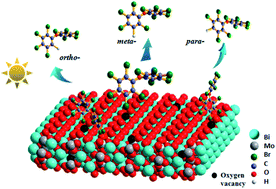Enhanced photodegradation of decabromodiphenyl ether on oxygen vacancy-enriched Bi2MoO6†
Abstract
Debromination is a primary and critical procedure in the treatment of polybrominated diphenyl ethers (PBDEs) in the environment. Herein, oxygen vacancy-enriched Bi2MoO6 is firstly applied in the photoreduction debromination of PBDEs under visible light illumination. The introduction of oxygen vacancies not only promotes the red-shift of the light absorption band by Bi2MoO6, but also activates the C–Br bond through the formation of Br–O halogen bonds, thus realizing efficient visible light reduction of decabromodiphenyl ether (BDE209). The activation adsorption mode inferred by tracking analysis of the degradation process shows that the meta-position adsorption mode is the main adsorption configuration during the activation process, while the ortho-position adsorption mode is the most difficult. Thence, the oxygen vacancy-dominated photocatalytic BDE209 process is a position-selective multi-electron reduction process. The study shows that oxygen vacancy assisted C–Br activation is an excellent strategy for photocatalytic treatment of halogenated persistent organic pollutants.



 Please wait while we load your content...
Please wait while we load your content...